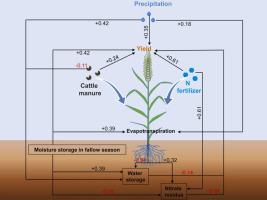Agriculture, Ecosystems & Environment ( IF 6.0 ) Pub Date : 2023-05-16 , DOI: 10.1016/j.agee.2023.108586 Wenguang Li , Long Ma , Fan Shi , Shuting Wang , Jiarui Zhao , Wei Zheng , Zhijun Li , Ziyan Li , Bingnian Zhai

|
Optimizing fertilization strategies to improve water utilization efficiency and obtain higher crop yields and low nitrate leaching is essential for balancing food security and environmental risks in the rain-fed area of the Loess Plateau. The eight consecutive years (2014–2022) field experiment followed a split-plot design, and the experimental factors were nitrogen application rate (N0, N75, N150, N225, and N300) and manure application rate (M0 and M1). In general, (1) the relationships between nitrogen application rate and grain yield (GY), crop N uptake and water utilization efficiency (WUE) followed a quadratic curve. Compared with chemical fertilizer alone (NPK), chemical fertilizer plus manure (MNPK) significantly increased the annual average grain yield by 28.5%, 18.3%, 8.9%, 6.9% and 4.2% at the N application rate of N0, N75, N150, N225 and N300. (2) The nitrate accumulation (SNA) in the same soil layer increased with the nitrogen application rate. The residue nitrate will increase dramatically when the N application rate exceeds 150 kg ha-1. The peaks of SNA gradually moved to the deeper layer with increasing years of fertilization. The total soil nitrate accumulation (TSNA) of NPK was significantly higher than that of MNPK in dry and normal years, but the opposite was true in wet years. The total soil water storage (TSWS) decreased and then increased with the N application rate, and the annual average TSWS of the MNPK treatments was 3.9% less than that of the NPK treatments. (3) The addition of manure significantly increased the annual average moisture storage rate (MSR) during the fallow season by 4.6%. The GY in dry and normal years was more dependent on MSR than that in wet years. In terms of the long-term effects, the MSR contributes more to GY than growing season precipitation (GSP), and the high MSR caused by manure application reduced TSNA and TSWS by promoting crop growth. The results showed that M1N150 could obtain a high grain yield while maintaining low nitrate residue. Taken together, this study emphasized the importance of optimizing nitrogen fertilizer management and cattle manure application in combination with precipitation types to ensure food production and reduce negative environmental effects in the rain-fed area of the Loess Plateau in China.











































 京公网安备 11010802027423号
京公网安备 11010802027423号